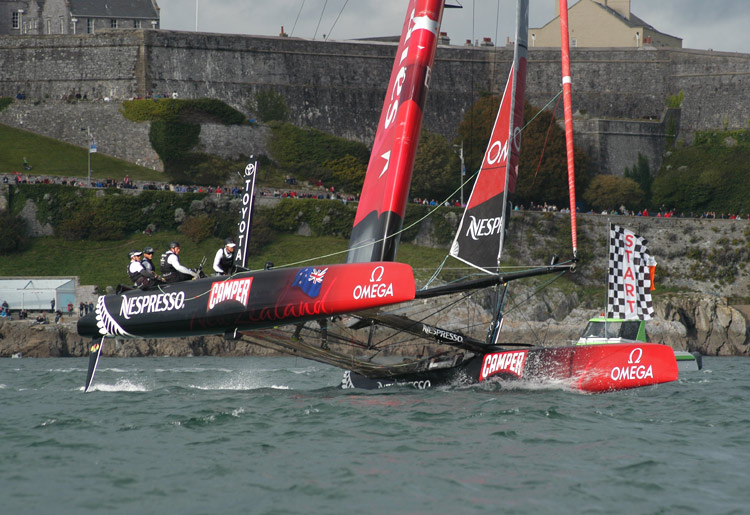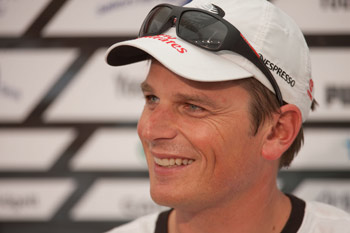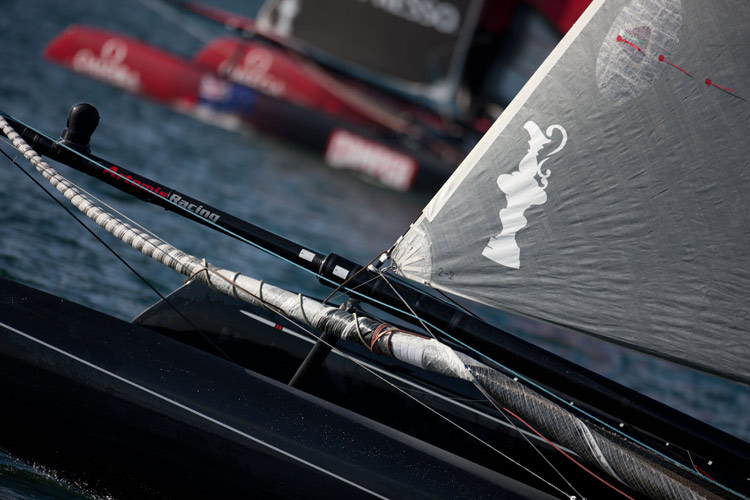|
November 20, 2011 |
||||
|
Dean Barker has made quite a name for himself in the America’s Cup, winning his first-ever race in the Cup in 2000 when Team New Zealand skipper Russell Coutts handed the helm to his young trial horse driver in the fifth and final race of the 30th Defense. And it was Barker and his Emirates Team New Zealand crew on the Challenger who gave Defender Alinghi all they could handle in the 2007 America’s Cup final. So perhaps Barker and ETNZ had the most to lose when Cup organizers sent the America’s Cup Class monohulls into the history books and forged a new path for the Cup, staking their collective reputations on the excitement and risks of a 72-foot catamaran, and on top of that, holding two seasons of regattas racing 45-foot versions of the winged cats. Some veterans were skeptical of the new boats, fearing their futures with the Cup would lost as decades of monohull experience would somehow became irrelevant, but Barker wasn’t one to worry over it -- the team wasted no time looking backwards. Instead, they bought an A-class catamaran to learn the ins and outs of cat sailing, embarked on an Extreme 40 campaign in the ultra competitive Extreme Sailing Series, and picked up two SL33 cats to be used for crew training and as design guinea pigs to explore options for the AC72. And all of that in addition to the ETNZ AC45 that was delivered last April. To say that it’s been a lightning-fast course in "Catamarans 101" is an understatement. “It’s been an incredibly steep learning curve for us,” said Barker. “The biggest challenge for us initially was making the transition, to understand what cat sailing is all about. We thought we had a pretty good grasp on monohull sailing, so to transition across has taken quite a bit of time and a lot of effort. Slowly but surely we’re getting there and I hope we can continue improving at a really good rate.” Barker and ETNZ have clearly been quick studies, judging from the lead in the match racing and fleet racing standings of the America’s Cup World Series that they carried heading into San Diego. In fact, ETNZ had equal match and fleet racing points after the Cascais and Plymouth events. They won the fleet racing in Cascais and finished second after Oracle Racing Spithill in Plymouth. In Match Racing, ETNZ scored a second place in match racing in Cascais while beating Team Korea for the Match Race title in Plymouth. ETNZ was beaten Friday in the ACWS San Diego Match Racing semi-finals by Oracle Racing Spithill, and finished third. “The most difficult thing has been to understand the boundaries and the limits of what these boats can and can’t do, and boat positioning. You know what you want to do most of the time, but actually being able to do it is a completely different thing. Whereas you could place an old Version Five boat on a dime, in these boats it’s much more difficult to understand what the boat will do -- how quickly it will accelerate or slow down, how will it tack and gybe. That part has been very difficult. And they accelerate fast -- they’re light and they have enough sail area when there’s breeze, so it’s amazing how quickly you can go from a dead stop to accelerating quickly.” One of the biggest hills to climb on the AC45 involves the new hard wing sails. But Barker is typically matter-of-fact regarding mastering the new design element, which will, by its very nature, be a much different proposition on the AC72 than it is on the AC45. “The 45’s wing sail is actually quite a basic wing. It’s very simple, it’s very robust, so it’s a very good tool for us to learn with. The 72-foot wings will be much more complicated, I’m sure, and probably a lot more fragile. But these have been fantastic. We learn little bits every time we go sailing on how we can handle them better and what effect they have on the maneuverability. They’re much nicer to sail with than a soft sail, particularly in these reaching courses.“ The latest news for ETNZ involves their training arrangement with Luna Rossa, a late entry accepted just weeks ago for the 34th America’s Cup. The two challenger candidates will trial in New Zealand on AC45s and share information as they design and build their first AC72s in cooperation. “The relationship with Luna Rossa is going to be good for us, once we get the 72’s into the water. It will certainly accelerate the learning curve with those boats. We have a limited number of days, so we have to be pretty quick to learn and develop.” The team’s AC72 will not splash until July, 2012, and the Protocol for the 34th Defense limits the teams to 30 AC72 sailing days before January 31, 2013. Design work runs apace as teams learn more about what they do want and don’t want based on their experience in the AC45. Barker and his sailing team work closely with Morelli & Melvin partner Pete Melvin, the author of the AC72 rule and now a designer for ETNZ. Few people know as much about a multihull as Melvin, and with three multihull world championships to his credit, he knows what sailors want. “The sailing team is actively involved in the design process and we’ve got a really strong design group back in Auckland, with Pete Melvin and a couple other guys from his office. The input is valuable -- different ideas, different concepts -- so hopefully it’s pushing us in the right direction. It’s been great working with these guys, because of their multihull experience and everything they can add back into the design process.” Typical of ETNZ’s way has been bringing in multi-faceted talent, so to speak, like Glenn Ashby, who was the 2008 Tornado catamaran World Champion with teammate Darren Bundock (himself now helming Oracle5). Ashby serves with the Kiwis as an AC45 wing trimmer and participates as a design team member. “Glenn Ashby has also been really valuable with his experience, so we’re learning more and more,” says Barker. A year ago, we couldn’t have made any input, because we just didn’t know what the boats were and how to manage them. We feel like now we have a much better understanding, but still we have a lot to learn.” Barker knows that the clock is moving, with barely 20 months to go between now and the start of the Louis Vuitton Cup in San Francisco in July, 2013. Plans for the next few months involve training, designing, and more training. “It sounds as though there will not be an event in January, so we’ll take our boat back to New Zealand and sail with the Luna Rossa guys there. There are other design projects we need to carry on with ourselves, so time is ticking very quickly. It won’t be long before we’ll be putting our AC72 into the water!” --Diane Swintal for CupInfo/©2011 CupInfo.com Dean Barker, Sailing Resume:
|
||||
|
Additional Links and Info: Visit ETNZ at Official America's Cup website Morelli & Melvin Design & Engineering Extreme 40/Extreme Sailing Series |


